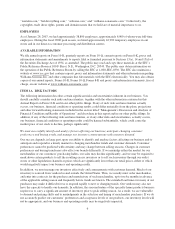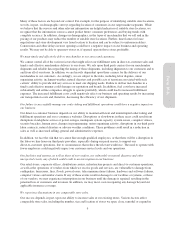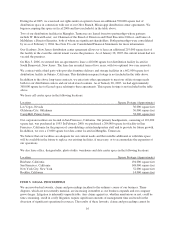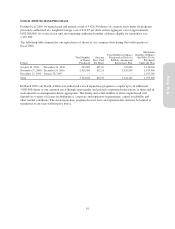Pottery Barn 2006 Annual Report Download - page 22
Download and view the complete annual report
Please find page 22 of the 2006 Pottery Barn annual report below. You can navigate through the pages in the report by either clicking on the pages listed below, or by using the keyword search tool below to find specific information within the annual report.any period, the general retail sales environment, consumer preferences and buying trends, changes in sales mix
among distribution channels, our ability to efficiently source and distribute products, changes in our merchandise
mix, competition (including competitive promotional activity), current local and global economic conditions, the
timing of our releases of new merchandise and promotional events, the success of marketing programs, the
cannibalization of existing store sales by our new stores, increased catalog circulation and continued strength in
our Internet business. Among other things, weather conditions can affect comparable store sales because
inclement weather can alter consumer behavior or require us to close certain stores temporarily and thus reduce
store traffic. Even if stores are not closed, many customers may decide to avoid going to stores in bad weather.
These factors have caused and may continue to cause our comparable store sales results to differ materially from
prior periods and from earnings guidance we have provided.
Our comparable store sales have fluctuated significantly in the past on an annual, quarterly and monthly basis,
and we expect that comparable store sales will continue to fluctuate in the future. Our comparable store sales
increases for fiscal 2006, fiscal 2005 and fiscal 2004 were 0.3%, 4.9% and 3.5%, respectively. Past comparable
store sales are no indication of future results, and comparable store sales may decrease in the future. Our ability
to maintain and improve our comparable store sales results depends, in large part, on maintaining and improving
our forecasting of customer demand and buying trends, selecting effective marketing techniques, providing an
appropriate mix of merchandise for our broad and diverse customer base and using effective pricing strategies.
Any failure to meet the comparable store sales expectations of investors and securities analysts in one or more
future periods could significantly reduce the market price of our common stock.
Our failure to successfully manage the costs and performance of our catalog mailings might have a negative
impact on our business.
Postal rate increases, paper costs, printing costs and other catalog distribution costs affect the cost of our catalog
mailings. We rely on discounts from the basic postal rate structure, which could be changed or discontinued at
any time. Our cost of paper has fluctuated significantly during the past three fiscal years, and our paper costs are
expected to increase in the future. Future increases in postal rates, paper costs or printing costs would have a
negative impact on our operating results to the extent that we are unable to pass such increases on directly to
customers or offset such increases by raising prices or by implementing more efficient printing, mailing, delivery
and order fulfillment systems.
We have historically experienced fluctuations in customer response to our catalogs. Customer response to our
catalogs is substantially dependent on merchandise assortment, merchandise availability and creative
presentation, as well as the selection of customers to whom the catalogs are mailed, changes in mailing strategies,
and the sizing and timing of delivery of the catalogs. In addition, environmental organizations may attempt to
create an unfavorable impression of our paper use in catalogs. The failure to effectively produce or distribute our
catalogs could affect the timing of catalog delivery. The timing of catalog delivery has been and can be affected
by postal service delays. For example, the August 2005 natural disaster caused by Hurricane Katrina created
domestic ground and rail transportation capacity constraints that resulted in late catalog delivery. Any delays in
the timing of catalog delivery could cause customers to forego or defer purchases.
We must successfully manage our Internet business.
The success of our Internet business depends, in part, on factors over which we have limited control. In addition
to changing consumer preferences and buying trends relating to Internet usage, we are vulnerable to certain
additional risks and uncertainties associated with the Internet, including changes in required technology
interfaces, website downtime and other technical failures, costs and technical issues as we upgrade our website
software, computer viruses, changes in applicable federal and state regulation, security breaches and consumer
privacy concerns. Our failure to successfully respond to these risks and uncertainties might adversely affect the
sales in our Internet business, as well as damage our reputation and brands.
10
























